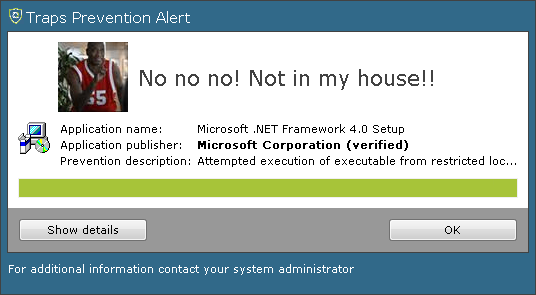Create a Custom User Alert Message
Table of Contents
Expand all | Collapse all
-
- Set Up the Endpoint Infrastructure
- Activate Traps Licenses
-
- Endpoint Infrastructure Installation Considerations
- TLS/SSL Encryption for Traps Components
- Configure the MS-SQL Server Database
- Install the Endpoint Security Manager Server Software
- Install the Endpoint Security Manager Console Software
- Manage Proxy Communication with the Endpoint Security Manager
- Load Balance Traffic to ESM Servers
-
- Malware Protection Policy Best Practices
- Malware Protection Flow
- Manage Trusted Signers
-
- Remove an Endpoint from the Health Page
- Install an End-of-Life Traps Agent Version
-
-
- Traps Troubleshooting Resources
- Traps and Endpoint Security Manager Processes
- ESM Tech Support File
-
- Access Cytool
- View the Status of the Agent Using Cytool
- View Processes Currently Protected by Traps Using Cytool
- Manage Logging of Traps Components Using Cytool
- Restore a Quarantined File Using Cytool
- View Statistics for a Protected Process Using Cytool
- View Details About the Traps Local Analysis Module Using Cy...
- View Hash Details About a File Using Cytool
Create a Custom User Alert Message

Traps
displays prevention and notification messages when a file or process
violates a security policy and the termination behavior is configured
to block the file and notify the user or to log the issue and notify
the user. Use an agent settings rule to customize the general settings
for all user alerts, including the display image and footer. You
can also configure the title that appears on user alerts related
to protection modules, restrictions, or unknown files.
- Create a new agent settings rule.Select SettingsAgentSettings and then Add a new rule.
- (Optional) Customize the icon and footer used
for all user alert messages.
- Select User Alerts and then select General Settings (icon and footer).
- Customize either or both of the following options:
- Icon—To select an image that will appear in place of the Traps icon in user alert messages, Browse to and then Upload a new image. The image must be less than 100KB in size. The preview on the right allows you to view an example of how the user alert message will look with the new icon.
- Action/Footer—To provide contact or other information along the bottom of the message, enter up to 250 characters. The preview on the right shows your changes as you make them. To specify an email address, use standard HTML format, for example:<a href="mailto://support@organization.com"> Help Desk</a>
- Select the Triggering Action: Prevention Mode or Notification Mode.
- (Optional) Customize the title text for user
alerts.
- From the User Alert Window drop-down,
select the type of user alert:
- Protection Modules—A user alert that Traps displays when it activates an exploit or malware protection module to protect a process or block suspicious behavior.
- Execution Restrictions—A user alert that Traps displays when a user opens an executable file from a location that is restricted by a restriction rule.
- Enter the title text to display on the specific user alert type.
- Select the Triggering Action: Prevention Mode or Notification Mode.
- From the User Alert Window drop-down,
select the type of user alert:
- (Optional)
Add Conditions to
the rule. By default, a new rule does not contain any conditions.To specify a condition, select the Conditions tab, select the condition in the Conditions list, and then Add it to the Selected Conditions list. Repeat this step to add more conditions, as needed. You can also define new Conditions.
- (Optional)
Define the Target
Objects to which to apply the rule.To define a smaller subset of target objects, select the Objects tab, and then enter one or more AD Users, AD Computers, AD Groups, AD Organizational Unit, Existing Endpoints, or Existing Groups in the Include or Exclude areas. The Endpoint Security Manager queries Active Directory to verify the users, computers, groups, or organizational units. The ESM Console also offers autocompletion as you type for existing endpoints and existing virtual groups.
- (Optional)
Review the rule name and description. The ESM Console automatically
generates the rule name and description based on the rule details
but permits you to change these fields, if needed.To override the autogenerated name, select the Name tab, clear the Activate automatic description option, and then enter a rule name and description of your choice.
- Save the agent settings rule.Do either of the following:
- Save the rule without activating it. This option is only available for inactive, cloned, or new rules. When you are ready to activate the rule, select the rule from the SettingsAgentSettings page and then click Activate.
- Apply the rule to activate it immediately.
After saving or applying a rule, you can return to the Settings page at any time to Delete or Deactivate the rule.
